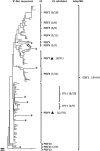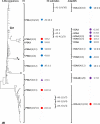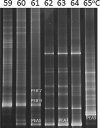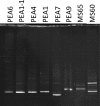Fine-scale distribution patterns of Synechococcus ecological diversity in microbial mats of Mushroom Spring, Yellowstone National Park
- PMID: 21890675
- PMCID: PMC3209189
- DOI: 10.1128/AEM.05927-11
Fine-scale distribution patterns of Synechococcus ecological diversity in microbial mats of Mushroom Spring, Yellowstone National Park
Abstract
Past analyses of sequence diversity in high-resolution protein-encoding genes have identified putative ecological species of unicellular cyanobacteria in the genus Synechococcus, which are specialized to 60°C but not 65°C in Mushroom Spring microbial mats. Because these studies were limited to only two habitats, we studied the distribution of Synechococcus sequence variants at 1°C intervals along the effluent flow channel and at 80-μm vertical-depth intervals throughout the upper photic layer of the microbial mat. Diversity at the psaA locus, which encodes a photosynthetic reaction center protein (PsaA), was sampled by PCR amplification, cloning, and sequencing methods at 60, 63, and 65°C sites. The evolutionary simulation programs Ecotype Simulation and AdaptML were used to identify putative ecologically distinct populations (ecotypes). Ecotype Simulation predicted a higher number of putative ecotypes in cases where habitat variation was limited, while AdaptML predicted a higher number of ecologically distinct phylogenetic clades in cases where habitat variation was high. Denaturing gradient gel electrophoresis was used to track the distribution of dominant sequence variants of ecotype populations relative to temperature variation and to O₂, pH, and spectral irradiance variation, as measured using microsensors. Different distributions along effluent channel flow and vertical gradients, where temperature, light, and O₂ concentrations are known to vary, confirmed the ecological distinctness of putative ecotypes.
Figures





Similar articles
-
Influence of molecular resolution on sequence-based discovery of ecological diversity among Synechococcus populations in an alkaline siliceous hot spring microbial mat.Appl Environ Microbiol. 2011 Feb;77(4):1359-67. doi: 10.1128/AEM.02032-10. Epub 2010 Dec 17. Appl Environ Microbiol. 2011. PMID: 21169433 Free PMC article.
-
Relationship between Microorganisms Inhabiting Alkaline Siliceous Hot Spring Mat Communities and Overflowing Water.Appl Environ Microbiol. 2020 Nov 10;86(23):e00194-20. doi: 10.1128/AEM.00194-20. Print 2020 Nov 10. Appl Environ Microbiol. 2020. PMID: 32978131 Free PMC article.
-
The molecular dimension of microbial species: 1. Ecological distinctions among, and homogeneity within, putative ecotypes of Synechococcus inhabiting the cyanobacterial mat of Mushroom Spring, Yellowstone National Park.Front Microbiol. 2015 Jun 22;6:590. doi: 10.3389/fmicb.2015.00590. eCollection 2015. Front Microbiol. 2015. PMID: 26157420 Free PMC article.
-
Microbial diversity in natural environments: focusing on fundamental questions.Antonie Van Leeuwenhoek. 2006 Nov;90(4):309-24. doi: 10.1007/s10482-006-9090-x. Epub 2006 Oct 25. Antonie Van Leeuwenhoek. 2006. PMID: 17063383 Review.
-
Molecular ecology of microbial mats.FEMS Microbiol Ecol. 2014 Nov;90(2):335-50. doi: 10.1111/1574-6941.12408. Epub 2014 Aug 28. FEMS Microbiol Ecol. 2014. PMID: 25109247 Review.
Cited by
-
Microdiversity of extracellular enzyme genes among sequenced prokaryotic genomes.ISME J. 2013 Jun;7(6):1187-99. doi: 10.1038/ismej.2012.176. Epub 2013 Jan 10. ISME J. 2013. PMID: 23303371 Free PMC article.
-
Community structure and function of high-temperature chlorophototrophic microbial mats inhabiting diverse geothermal environments.Front Microbiol. 2013 Jun 3;4:106. doi: 10.3389/fmicb.2013.00106. eCollection 2013. Front Microbiol. 2013. PMID: 23761787 Free PMC article.
-
Surprisingly extensive mixed phylogenetic and ecological signals among bacterial Operational Taxonomic Units.Nucleic Acids Res. 2013 May 1;41(10):5175-88. doi: 10.1093/nar/gkt241. Epub 2013 Apr 9. Nucleic Acids Res. 2013. PMID: 23571758 Free PMC article.
-
Temperature and Geographic Location Impact the Distribution and Diversity of Photoautotrophic Gene Variants in Alkaline Yellowstone Hot Springs.Microbiol Spectr. 2022 Jun 29;10(3):e0146521. doi: 10.1128/spectrum.01465-21. Epub 2022 May 16. Microbiol Spectr. 2022. PMID: 35575591 Free PMC article.
-
Temperature-Dependent Network Modules of Soil Methanogenic Bacterial and Archaeal Communities.Front Microbiol. 2019 Mar 12;10:496. doi: 10.3389/fmicb.2019.00496. eCollection 2019. Front Microbiol. 2019. PMID: 30915063 Free PMC article.
References
-
- Allewalt J. P., Bateson M. M., Revsbech N. P., Slack K., Ward D. M. 2006. Effect of temperature and light on growth of and photosynthesis by Synechococcus isolates typical of those predominating in Octopus Spring microbial mat community of Yellowstone National Park. Appl. Environ. Microbiol. 72:544–550 - PMC - PubMed
-
- Altschul S. F., Gish W., Miller W., Myers E. W., Lipman D. J. 1990. Basic local alignment search tool. J. Mol. Biol. 215:403–410 - PubMed
-
- Béjà O., Spudich E. N., Spudicn J. L., Leclerc M., DeLong E. F. 2001. Proteorhodopsin phototrophy in the ocean. Nature 411:786–789 - PubMed
-
- Bhaya D., et al. 2007. Population level functional diversity in a microbial community revealed by comparative genomic and metagenomic analysis. ISME J. 1:703–713 - PubMed
Publication types
MeSH terms
Substances
Associated data
- Actions
- Actions
- Actions
- Actions
- Actions
- Actions
- Actions
- Actions
- Actions
- Actions
- Actions
- Actions
- Actions
- Actions
- Actions
- Actions
- Actions
- Actions
- Actions
- Actions
- Actions
- Actions
- Actions
- Actions
- Actions
- Actions
- Actions
- Actions
- Actions
- Actions
- Actions
- Actions
- Actions
- Actions
- Actions
- Actions
- Actions
- Actions
- Actions
- Actions
- Actions
- Actions
- Actions
- Actions
- Actions
- Actions
- Actions
- Actions
- Actions
- Actions
- Actions
- Actions
- Actions
- Actions
- Actions
- Actions
- Actions
- Actions
- Actions
- Actions
- Actions
- Actions
- Actions
- Actions
- Actions
- Actions
- Actions
- Actions
- Actions
- Actions
- Actions
- Actions
- Actions
- Actions
- Actions
- Actions
- Actions
- Actions
- Actions
- Actions
- Actions
- Actions
- Actions
- Actions
- Actions
- Actions
- Actions
- Actions
- Actions
- Actions
- Actions
- Actions
- Actions
- Actions
- Actions
- Actions
- Actions
- Actions
- Actions
- Actions
- Actions
- Actions
- Actions
- Actions
- Actions
- Actions
- Actions
- Actions
- Actions
- Actions
- Actions
- Actions
- Actions
- Actions
- Actions
- Actions
- Actions
- Actions
- Actions
- Actions
- Actions
- Actions
- Actions
- Actions
- Actions
- Actions
- Actions
- Actions
- Actions
- Actions
- Actions
- Actions
- Actions
- Actions
- Actions
- Actions
- Actions
- Actions
- Actions
- Actions
- Actions
- Actions
- Actions
- Actions
- Actions
- Actions
- Actions
- Actions
- Actions
- Actions
- Actions
- Actions
- Actions
- Actions
- Actions
- Actions
- Actions
- Actions
- Actions
- Actions
- Actions
- Actions
- Actions
- Actions
- Actions
- Actions
- Actions
- Actions
- Actions
- Actions
- Actions
- Actions
- Actions
- Actions
- Actions
- Actions
- Actions
- Actions
- Actions
- Actions
- Actions
- Actions
- Actions
- Actions
- Actions
- Actions
- Actions
- Actions
- Actions
- Actions
- Actions
- Actions
- Actions
- Actions
- Actions
- Actions
- Actions
- Actions
- Actions
- Actions
- Actions
- Actions
- Actions
- Actions
- Actions
- Actions
- Actions
- Actions
- Actions
- Actions
- Actions
- Actions
- Actions
- Actions
- Actions
- Actions
- Actions
- Actions
- Actions
- Actions
- Actions
- Actions
- Actions
- Actions
- Actions
- Actions
- Actions
- Actions
- Actions
- Actions
- Actions
- Actions
- Actions
- Actions
- Actions
- Actions
- Actions
- Actions
- Actions
- Actions
- Actions
- Actions
- Actions
- Actions
- Actions
- Actions
- Actions
- Actions
- Actions
- Actions
- Actions
- Actions
- Actions
- Actions
- Actions
- Actions
- Actions
- Actions
- Actions
- Actions
- Actions
- Actions
- Actions
- Actions
- Actions
- Actions
- Actions
- Actions
- Actions
- Actions
- Actions
- Actions
- Actions
- Actions
- Actions
- Actions
- Actions
- Actions
- Actions
- Actions
- Actions
- Actions
- Actions
- Actions
- Actions
- Actions
- Actions
- Actions
- Actions
- Actions
- Actions
- Actions
- Actions
- Actions
- Actions
- Actions
- Actions
- Actions
- Actions
- Actions
- Actions
- Actions
- Actions
- Actions
- Actions
- Actions
- Actions
- Actions
- Actions
- Actions
- Actions
- Actions
- Actions
- Actions
- Actions
- Actions
- Actions
- Actions
- Actions
- Actions
- Actions
- Actions
- Actions
- Actions
- Actions
LinkOut - more resources
Full Text Sources
Miscellaneous

